Environment and Ecology: October 2023 UPSC Current Affairs | Environment for UPSC CSE PDF Download
Tilapia Parvovirus
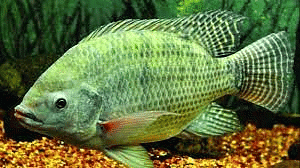
Context
The discovery of Tilapia parvovirus (TiPV) in farm-bred tilapia in Ranipet district, Tamil Nadu, negatively affected the aquaculture industry in the State.
Tilapia Parvovirus (TiPV)
About
- Tilapia aquaculture, a significant global protein source, is under a serious threat from Tilapia Parvovirus (TiPV).
- First identified in China in 2019, TiPV has quickly spread to countries including Thailand and India, posing a substantial risk to the worldwide supply of tilapia protein.
- The highly contagious nature of TiPV has resulted in considerable economic losses for fish farmers in affected areas.
- The rapid transmission of the virus has led to financial challenges in the tilapia industry, affecting the livelihoods of individuals reliant on aquaculture.
Characteristics of TiPV
- TiPV belongs to the Parvoviridae family and primarily affects tilapia fish species.
- The virus can cause a range of symptoms, including loss of appetite, lethargy, difficulty swimming, pale gills, haemorrhages on the skin and fins, and, in severe cases, death.
- TiPV, a DNA virus, exhibits a mortality rate of 30-50% in farms and 100% in laboratory settings, posing a significant threat to agricultural and research environments.
Transmission of TiPV
- TiPV spreads through direct contact with infected fish or contaminated water sources.
- Rapid transmission is common in densely populated fish ponds within aquaculture environments.
- The introduction of infected fish or contaminated equipment accelerates the virus's dissemination.
- Early detection and proactive prevention are crucial to controlling TiPV due to its highly contagious nature.
Symptoms and Impact on Tilapia Population
- TiPV symptoms, including loss of appetite and lethargy, weaken tilapia populations, compromising their overall health.
- Infected fish are prone to secondary infections due to weakened immune systems, amplifying mortality rates.
- TiPV impact not only results in high fish mortality but also reduces the quality of tilapia produced.
- It leads to economic losses for fish farmers, emphasizing the need for effective disease management strategies.
Preventive Measures
- Regularly monitor water quality parameters like pH, temperature, and oxygen levels to ensure clean and well-maintained water, reducing stress on fish and lowering the risk of infections.
- Avoid overcrowding in fish ponds as it creates stressful conditions, increasing the likelihood of disease outbreaks. Maintain proper stocking density and conduct regular thinning of populations to prevent rapid TiPV spread.
- Source fish from reputable, disease-free hatcheries to minimize the risk of introducing infected individuals into existing populations.
- Quarantine new fish before introducing them to established ponds to monitor their health and prevent the spread of infections to the existing population.
- Promptly remove and properly dispose of dead fish to prevent the virus from contaminating the water and affecting other fish.
- Implement strict biosecurity measures, including disinfection protocols and controlling access to aquaculture facilities, to prevent the introduction and spread of TiPV.
Conclusion
- Tilapia Parvovirus (TiPV) poses a serious threat to aquaculture, demanding urgent action. Strict biosecurity, water quality management, and research efforts are key to mitigating its impact and securing the future of tilapia farming.
- Collaborative research is vital for developing preventive strategies against TiPV outbreaks.
Ammonia as a Automotive Fuel
Context
- In the automotive industry, there is growing interest in an internal combustion engine fueled by ammonia. This innovative approach is gaining attention because it explores alternative propulsion methods without completely abandoning traditional Internal Combustion Engine (ICE) systems or transitioning to Battery Electric Vehicles (BEVs).
- Malaysian energy giant Petroliam Nasional (Petronas) and Singapore's sovereign wealth fund GIC will invest in a project to produce five million tonnes of green ammonia a year in India by 2030.
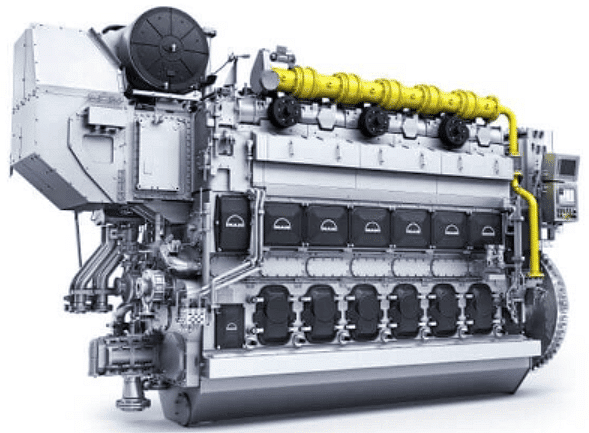
Internal Combustion Engine (ICE) Systems
- Definition and Operation: ICE systems utilize traditional engines that combust fossil fuels (such as petrol or diesel) to generate power. The fuel-air mixture ignites, creating an explosion that propels the vehicle forward.
- Applications: These systems are commonly found in a range of vehicles, including cars, trucks, and motorcycles, powering their wheels through combustion-driven mechanisms.
- Environmental Impact: ICE vehicles emit exhaust gasses, contributing to air pollution and greenhouse gas emissions, making them a concern for environmental sustainability.
Battery Electric Vehicles (BEVs)
- Definition and Power Source: Battery Electric Vehicles (BEVs) are vehicles that solely rely on rechargeable batteries to operate an electric motor. These batteries must be recharged using electricity obtained from the grid.
- Charging and Energy Sources: BEVs need electricity for charging, which can be obtained from diverse outlets, including renewable energy sources. This makes BEVs a more environmentally friendly option compared to conventional vehicles.
- Emission Reduction: BEVs generate no tailpipe emissions, thus playing a crucial role in environmental conservation by substantially decreasing air pollution.
Major Applications of Ammonia
- Agriculture: Ammonia is crucial in the production of ammonia-based fertilizers like ammonium nitrate and urea, vital for crop growth.
- Chemical Industry: It serves as a fundamental ingredient in producing substances such as nitric acid, ammonium sulfate, and various nitrogen-based compounds. Additionally, ammonia is used in manufacturing synthetic fibers like nylon.
- Manufacturing and Household: In industrial settings, it functions as a refrigerant in refrigeration systems and air conditioning. It's also utilized in dye manufacturing and as a pH regulator in dyeing processes. Moreover, it's an ingredient in household cleaning products.
Advantages of Using Ammonia as a Fuel
- High Energy Density: Ammonia possesses high energy density, suitable for long-term applications, being nine times more energy-dense than lithium-ion batteries and three times that of compressed hydrogen.
- Low Carbon Emissions: Ammonia has the potential to produce nearly zero carbon dioxide emissions during combustion, making it eco-friendly, especially in comparison to fossil fuels.
- Bridge Fuel: It can act as a transitional fuel, reducing reliance on traditional fossil fuels, thereby enhancing energy security and diversifying the energy mix.
Challenges Associated with Using Ammonia as a Fuel
- Environmental Impact: Despite low CO2 emissions, current ammonia engines emit pollutants, including unburned ammonia and nitrogen oxides, leading to environmental and health risks.
- Production Challenges: Traditional ammonia production processes are energy-intensive and reliant on fossil fuels. Green ammonia production, using renewable energy, faces hurdles in terms of cost and scalability.
- Toxicity and Safety Concerns: Ammonia is highly toxic and corrosive, posing risks to both humans and the environment if not handled carefully. Accidents or mishandling could have severe consequences.
- Fuel Quality Standards: Establishing consistent quality standards for ammonia as a fuel is complex, especially considering variations in production sources and impurity levels.
The Way ahead
- Research and Development: Ammonia plays a vital role in the production of fertilizers like ammonium nitrate and urea, which are essential for promoting crop growth.
- Safety Training: Ammonia serves as a crucial component in the synthesis of substances such as nitric acid, ammonium sulfate, and various nitrogen-based compounds. Additionally, it is used in the manufacturing of synthetic fibers like nylon.
- Market Incentives: In industrial settings, ammonia is employed as a refrigerant in refrigeration systems and air conditioning. It is also utilized in dye manufacturing and serves as a pH regulator in dyeing processes. Furthermore, ammonia is an ingredient in household cleaning products.
- Ammonia Hybrids: In industrial applications, ammonia functions as a refrigerant in refrigeration systems and air conditioning. It is also employed in dye manufacturing and acts as a pH regulator in dyeing processes. Additionally, it is a component in household cleaning products.
Impact of Disasters on Agriculture and Food Security: FAO
Why in News?
Recently, the Food and Agriculture Organization (FAO) has released a report titled 'The Impact of Disaster on Agriculture and Food Security' stating that the frequency of Extreme Disaster events has risen significantly over the past 50 years.
- The report estimated losses caused by disasters on agricultural production over the past three decades and delves into the diverse threats and impacts affecting the crops, livestock, forestry, and fisheries and aquaculture subsectors.
- It analyzed the complex interplay of underlying risks, such as Climate Change, Pandemics, Epidemics and Armed conflicts, and how they drive disaster risk in agriculture and Agrifood systems at large.
What are the Key Highlights of the Report?
- Magnitude of Agricultural Losses:
- Over the last 30 years, an estimated USD 3.8 trillion worth of crops and livestock production has been lost due to disaster events.
- This translates to an average annual loss of USD 123 billion, which is approximately 5% of the global agricultural Gross Domestic Product (GDP).
- Agriculture is one of the most highly exposed and vulnerable sectors in the context of disaster risk, given its profound dependence on natural resources and climate conditions.
- Recurrent disasters have the potential to erode gains in food security and undermine the sustainability of agrifood systems.
- Impact on Different Countries:
- Disasters have the highest relative impact on lower and lower middle-income countries, where they can cause losses of up to 15 % of their total agricultural GDP.
- Small Island Developing States (SIDS) also experience significant losses, amounting to nearly 7% of their agricultural GDP.
- Losses by Product Groups:
- There are increasing trends in losses related to major agricultural products.
- Cereals are the most affected, followed by fruits and vegetables and sugar crops, with average losses of millions of tonnes each year.
- Meats, dairy products, and eggs also show substantial losses.
- Regional Differences:
- Asia experiences the largest share of total economic losses, followed by Africa, Europe, and the Americas.
- However, in Asia, these losses account for a smaller percentage of agricultural added value compared to Africa.

- Increasing Frequency of Disasters:
- Disaster events have been on the rise, increasing from 100 per year in the 1970s to around 400 events per year worldwide in the past two decades.
- These events are becoming more frequent, intense, and complex, with expected worsening impacts due to climate-induced disasters.
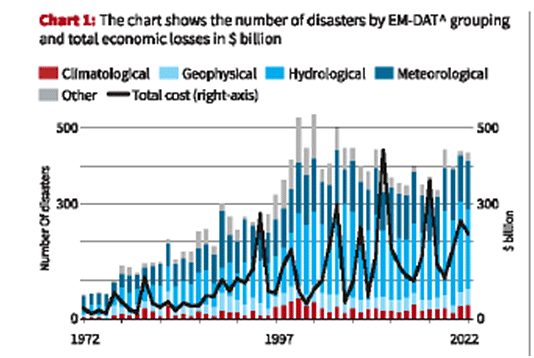
- Impact on Vulnerable Groups:
- Small-scale farmers, particularly those practicing Rain-Fed agriculture, are the most vulnerable to disaster impacts.
- Supporting the adoption of farm-level disaster risk reduction practices can help reduce losses and enhance resilience.
- Investment in farm-level disaster risk reduction good practices can perform on average 2.2 times better than previously applied practices.
What are the Recommendations?
- Proactive and timely interventions, such as anticipatory actions in response to forecasted hazards, can significantly reduce disaster risks in agriculture.
- For every USD 1 invested in anticipatory action, rural families can gain up to USD 7 in benefits and avoided agricultural losses.
- The report outlines three key priorities for addressing the impact of disasters on agriculture:
- Improving data and information on disaster impacts, developing multi-sectoral and multi-hazard disaster risk reduction approaches, and enhancing investments in resilience to reduce disaster risk in agriculture and improve livelihoods.
Implementing Kunming-Montreal Global Biodiversity Framework
Why in News?
Recently, the 25th meeting of the Subsidiary Body on Scientific, Technical and Technological Advice (SBSTTA-25) in Nairobi, Kenya concluded with recommendations aimed at facilitating the transition from agreement to action following the adoption of the Kunming-Montreal Global Biodiversity Framework (KMGBF) in December 2022.
- The meeting primarily focused on creating a progress monitoring mechanism, while also addressing the implications of assessments conducted by the Intergovernmental Science-Policy Platform on Biodiversity and Ecosystem Services (IPBES) and the Sixth Assessment Report of the Intergovernmental Panel on Climate Change (IPCC AR6), among other matters.
What Was the Recent SBSTTA-25 Meeting About?
- IPBES Reports on Invasive Species and Biodiversity Valuation:
- The recent IPBES report has highlighted the critical role that invasive species play in driving the extinction of plants and animals. Additionally, the Methodological Assessment Report on Diverse Values and Valuation of Nature, as well as the Thematic Assessment Report on the Sustainable Use of Wild Species, were discussed.
- These findings shed light on the intricate relationship between biodiversity and the impact of invasive species.
- IPCC AR6 Findings on Biodiversity and Climate Change:
- The findings from the IPCC AR6 report were also a focal point of discussion. The report underscores that climate change is the primary driver of biodiversity loss and emphasizes the capacity of biodiversity to support climate adaptation, resilience, mitigation, and disaster risk reduction.
- This connection between biodiversity and climate change has significant implications for global environmental management.
- Converging Crises
- During the meeting, experts recognized that biodiversity loss, climate change, ocean acidification, desertification, land degradation, invasive alien species, and pollution are interconnected crises.
- Recommendations:
- To address these challenges coherently and effectively, the group finalized 15 key points for presentation at the 16th meeting of the Conference of the Parties (COP16) to the Convention on Biological Diversity (CBD).
- This approach aligns with the goals of the Convention, the Kunming-Montreal Global Biodiversity Framework, and other global initiatives such as the United Nations Framework Convention on Climate Change and the 2030 Agenda on Sustainable Development.
- Moreover, the meeting emphasized the importance of utilizing the work of other multilateral agencies, including the World Health Organization and the Food and Agriculture Organization, to enhance scientific and technical guidance in implementing the Kunming-Montreal Global Biodiversity Framework.
What is Kunming-Montreal Global Biodiversity Framework?
- About:
- The Kunming-Montreal Global Biodiversity Framework (GBF) was adopted during the fifteenth meeting of the Conference of the Parties (COP)-15 of CBD following a four year consultation and negotiation process.
- This historic Framework, which supports the achievement of the Sustainable Development Goals and builds on the Convention’s previous Strategic Plans, sets out an ambitious pathway to reach the global vision of a world living in harmony with nature by 2050.
- 30 by 30 Target:
- The declaration made a reference to the '30 by 30' target which is a key proposal being debated at the COP15, that would afford 30% of the Earth’s land and oceans protected status by 2030.
- Main Targets:
- The framework consists of four goals for 2050 and 23 targets for 2030.
- The four goals are:
- Conserve and restore biodiversity.
- Ensure sustainable use of biodiversity.
- Share benefits fairly and equitably.
- Enable transformative change.
- The 23 Targets are:

Dancing Frogs
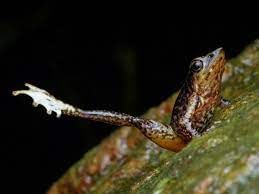
Overview
According to the Wildlife Trust of India the dancing frogs are the most threatened amphibian genus of India.
About Dancing frogs
- These are endemic to the Western Ghats.
- Habitat: The species was found to prefer habitats in areas with thick canopy cover of at least 70-80 per cent
- It belongs to the Micrixalus genus.
- It is also the fifth most threatened genus in the world with 92 per cent of its species in the threatened category
- Behaviour
- The dancing frogs that are found near the streams do a unique display to mate.
- The males stretch up their hind legs one at a time and wave their webbed toes in the air in a rapid motion akin to a dance.
- This is to attract mates as well as ward off competition, probably preferred because their mating calls are drowned out by the gurgling of the streams.
- This act is called “foot flagging” and gives the species their name.
- Ecological significance:
- Frogs are valuable in the food chain and also provide other ecological services.
- Threats: These species are threatened by invasive species like the mosquito fish, land use change, variation in temperature and humidity, extreme weather events such as floods and excess rainfall, infectious diseases, water pollution, light pollution, and infrastructure projects.
Amphibians Threatened by Climate Change
Why in News?
Recently, the study titled 'Ongoing declines for the world’s amphibians in the face of emerging threats' published in the Nature journal reveals significant threats to Amphibians worldwide particularly from Climate Change.
- The study is based on the second global amphibian assessment coordinated by the Amphibian Red List Authority, a branch of the Amphibian Specialist Group of the International Union for Conservation of Nature’s (IUCN) Species Survival Commission.
- The assessment evaluated the extinction risk of more than 8,000 amphibian species from all over the world, including 2,286 species evaluated for the first time
What are the Key Highlights of the Study?
- Extinction Risk:
- Two out of every five amphibian species are threatened with extinction.
- 40.7% of the species being globally threatened – highest for any species. This is compared to 26.5% of mammals, 21.4% of reptiles and 12.9% of birds.
- Between 2004 and 2022, over 300 amphibian species have moved closer to extinction, with climate change identified as the primary threat for 39% of these species.
- Amphibians are particularly sensitive to environmental changes, making them vulnerable to the effects of climate change.
- Amphibians Gone Extinct:
- Four amphibian species were documented as having gone extinct since 2004 — the Chiriquí harlequin toad (Atelopus chiriquiensis) from Costa Rica, the sharp-snouted day frog (Taudactylus acutirostris) from Australia, Craugastor myllomyllon and the Jalpa false brook salamander (Pseudoeurycea exspectata), both from Guatemala.
- Greatest Concentration of Threatened Amphibians:
- The greatest concentrations of threatened amphibians were found to be in the Caribbean islands, Mexico and Central America, the tropical Andes region, India's Western Ghats, Sri Lanka, Cameroon, Nigeria and Madagascar.
- Human Impact:
- Habitat destruction and degradation due to activities such as agriculture, infrastructure development, and other industries remain the most common threats to amphibians, affecting 93% of all threatened species.
- Disease and Overexploitation:
- Disease caused by the chytrid fungus and overexploitation continue to contribute to amphibian declines.
- Disease and habitat loss drove 91 % of status deteriorations between 1980 and 2004.
- Ongoing and projected climate change effects are now of increasing concern, driving 39% of status deterioration since 2004, followed by habitat loss amounting to 37%.
- Salamander Threat:
- Three out of every five salamander species are threatened with extinction, primarily due to habitat destruction and climate change.
- Salamanders are identified as the world's most threatened group of amphibians.
- Amphibians first appeared more than 300 million years ago. Three orders of amphibians exist today:
- Salamanders and newts (60% threatened with extinction); frogs and toads (39%); and the limbless and serpentine caecilians (16%).
- Conservation Action:
- Conservationists plan to use the study's findings to develop a global conservation action plan, prioritize conservation efforts, secure additional resources, and influence policies to reverse the negative trend for amphibians.
Coral Reef Breakthrough
Context
The International Coral Reef Initiative (ICRI), in collaboration with the Global Fund for Coral Reefs (GFCR) and the High-Level Climate Champions (HLCC), has launched the Coral Reef Breakthrough.
- This initiative aims to safeguard at least 125,000 square kilometres of shallow-water tropical coral reefs by 2030 through investments of at least US$12 billion.
The Coral Reef Breakthrough will focus on four action points
- Mitigating local drivers of loss, including land-based pollution, coastal development, and overfishing.
- Doubling the area of coral reefs under effective protection by aligning with global coastal protection targets.
- Accelerating restoration efforts to impact 30% of degraded reefs by 2030.
- Securing investments of at least USD 12 billion by 2030 from public and private sources to conserve and restore coral ecosystems.
- Coral reefs are underwater ecosystems made up of colonies of tiny corals called polyps. These marine invertebrates have hard exoskeletons made of calcium carbonate. They are sessile, meaning they are permanently fixed in one place.
- Coral reefs are massive structures made of limestone deposited by coral polyps. They are sometimes called the “rainforests of the sea” because they support approximately 25 per cent of all known marine species.

Ganges River Dolphin
River dolphins are a group of freshwater cetaceans, or marine mammals, that have adapted to live in rivers and freshwater ecosystems.
- They are distinct from their ocean-dwelling counterparts and have evolved unique characteristics to thrive in freshwater environments.
- They are found in various parts of the world, and they are known for their social behavior and unique physical features.
- They typically have a flexible, elongated body shape that is adapted to maneuver in river currents.
- They have unfused neck vertebrae, allowing them to turn their heads freely.
- They have reduced eyesight, as their underwater habitat does not require highly developed vision. They primarily rely on echolocation for navigation and hunting.
- They are known for their social behavior and can be found in small groups or pods.
- They are often solitary or in smaller groups, which may join together for feeding and socializing.
- They are known for their playful and acrobatic behavior, including leaping out of the water.
River dolphins act as indicators of river health in the basins where they live. If their population in a river is thriving, then the overall state of that freshwater system is also likely flourishing. But if that population is on the decline, then it’s considered a red flag for the ecosystem as a whole.
Species of River Dolphins
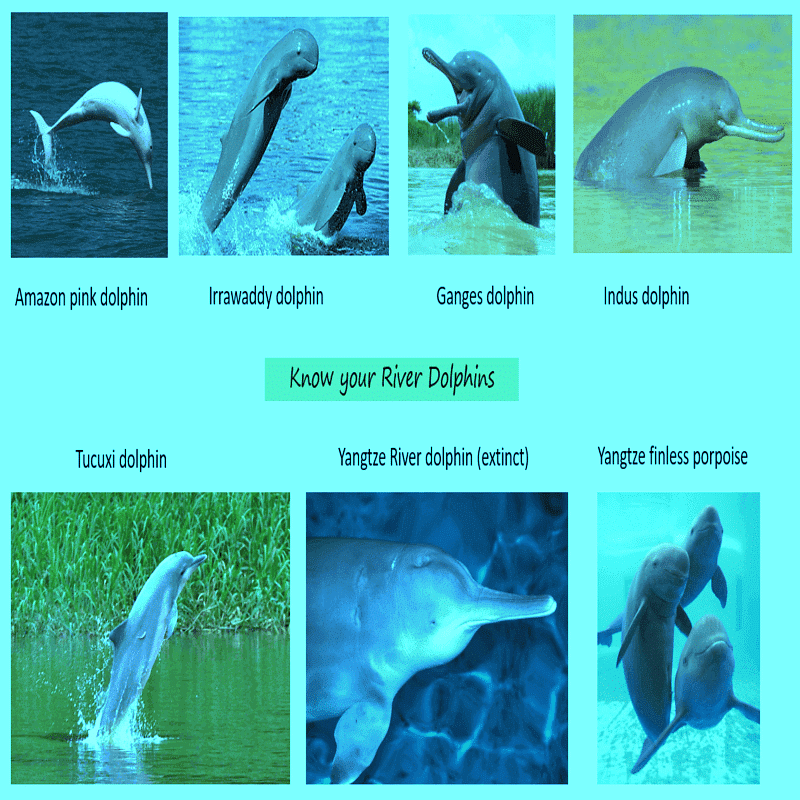
Amazon Dolphin (Inia geoffrensis): Also known as the boto or pink river dolphin, they are found in the Amazon and Orinoco River basins in South America.
- It is known for its pink coloration and is the largest of the species.
- IUCN Status: Endangered
Ganges River Dolphin (Platanista gangetica): The Gangetic dolphin, is found in the Ganges-Brahmaputra-Meghna and Karnaphuli river systems of India, Bangladesh, and Nepal.
- It is one of the most endangered freshwater dolphins.
- IUCN Status: Endangered
Indus River Dolphins (Platanista minor): They are native to the Indus River in Pakistan.
- It is one of the rarest and most endangered dolphin species, primarily due to habitat degradation and water pollution.
- The Bhulan, also called the Bhulan dolphin, is found in the Sutlej River in Pakistan and the Beas River in India. It is closely related to the Indus dolphin.
- IUCN Status: Endangered
Irrawaddy Dolphin (Orcaella brevirostris): Irrawaddy dolphins are found in coastal areas in South and Southeast Asia and three rivers i.e., Ayeyarwady (Myanmar), Mahakam (Indonesian Borneo), Mekong and Chillika Lake (India).
- They are known for their unique behavior, such as “spy-hopping,” where they rise vertically out of the water to observe their surroundings. They are often seen near the water’s surface.
- IUCN Status: Endangered
Tucuxi Dolphin (Sotalia fluviatilis): The Tucuxi dolphin are freshwater dolphin species that lives in the Amazon River system in Brazil, Colombia, Ecuador, and Peru.
- These are known for their acrobatic behaviors, including leaping and riding the bow waves created by boats.
- IUCN Status: Endangered
Yangtze River Dolphin (Lipotes vexillifer): The Yangtze River dolphin, or baiji, was found in China’s Yangtze River.
- Sadly, it is considered functionally extinct since 2006, as there have been no confirmed sightings since the early 2000s.
- The Yangtze finless porpoise lives in the Yangtze River, the longest river in Asia. At one point, this porpoise shared the waters with the Baiji.
- The Yangtze finless porpoise is known for its mischievous smile.
- IUCN Status: Critically Endangered
La Plata River Dolphin (Pontoporia blainvillei): These are also known as the Franciscans, inhabit the coastal waters and estuaries of South America, primarily in the La Plata Basin, which includes Brazil, Uruguay, and Argentina.
Another species- the Chinese river dolphin – was declared ‘probably extinct’ in 2007.
Threats and Conservation
River dolphins are threatened by a range of factors, including habitat loss due to dam construction, water pollution, overfishing, and entanglement in fishing gear.
- Dredging, pollution, and boat strikes from shipping and transportation on the river threaten the dolphins.
- Sand mining and illegal fishing also impacted the species.
- Many dolphin populations are listed as endangered or critically endangered by conservation organizations.
Conservation efforts aim to protect river dolphin habitats, mitigate human impacts, and raise awareness about the importance of these unique species in freshwater ecosystems.
- While the overall global picture is bleak, conservation efforts have proven successful in halting the decline of some river dolphin species, including in some of the most densely populated river basins in the world, such as the Indus and Yangtze.
- In Pakistan, the population of endangered Indus dolphins has almost doubled over the last 20 years due to collective action by the government, communities, and NGOs, including WWF.
- However, there are still only around 2,000 Indus dolphins and WWF is working with communities to reduce pollution, release dolphins entangled in fishing gear, and rescue dolphins trapped in irrigation canals.
- The number of critically endangered Yangtze finless porpoises – the only freshwater porpoise in the world – has increased by 23% over the past five years.
- This is the first increase since records began and is a result of strict protection measures and conservation efforts. Despite this, there are still only 1,249 Yangtze finless porpoises.
- The South American River Dolphin Initiative has also demonstrated the power of partnerships, by bringing organizations together to advance science, satellite tag river dolphins to discover more about their movement and behavior, and raise awareness about the role of river dolphins – and the threats to their survival.
Global Declaration of River Dolphins
The Global Declaration for River Dolphins aims to halt the decline of all river dolphin species and increase the most vulnerable populations.
- It will scale up collective efforts to safeguard the remaining river dolphin species, by developing and funding measures to eradicate gillnets, reduce pollution, expand research, and increase protected areas.
- It also aims to enhance the health of rivers, which are the lifeblood of many communities and economies as well as sustaining critical ecosystems from rainforests to deltas.
The eight pillars of the Declaration are:
- Creating a network of protected areas
- Enhancing management of river dolphin sites
- Expanding research and monitoring
- Engaging local communities and Indigenous Peoples
- Eradicating unsustainable fishing practices
- Improving water quality and quantity
- Celebrating World River Dolphin Day to raise awareness
- Increasing resource allocation and partnerships
River dolphin range states that adopted the Global Declaration for River Dolphins include Bangladesh, Bolivia, Brazil, Cambodia, Colombia, Ecuador, India, Nepal, Pakistan, Peru, and Venezuela. There was also a representative from the regional government in Indonesia that was responsible for the Mahakam River.
India’s Efforts for Conservation of Dolphin
As per studies conducted on river dolphin, the population of Gangetic dolphin in the mainstream Ganga are known to be stable, although there has been a decline in tributaries. The important steps taken by the Government for the conservation of the Gangetic dolphin include:
- Gangetic river dolphin is listed in Schedule –I of the Wild Life (Protection) Act, 1972, according to the highest degree of protection.
- Gangetic river dolphin has been designated as the National Aquatic Animal of India.
- The Ministry has included the Gangetic River dolphin as one of the 22 critically endangered species for providing financial assistance to States under the Centrally sponsored scheme ‘Development of Wildlife Habitats’.
- Important habitats of Gangetic River dolphins along the Ganges River have been notified as Protected Areas, such as Vikramshila Dolphin Sanctuary, Bihar.
- A comprehensive action plan (2022-2047) has been developed to ensure the well-being of the river dolphin and aquatic habitats, the role of various stakeholders and line Ministries have been identified.
- Project Dolphin is an Indian government initiative to conserve both riverine and oceanic dolphin species launched in 2021.
Way forward
- Habitat Conservation: Protect and restore natural habitats, particularly river systems and associated ecosystems. Address pollution and preserve freshwater ecosystems to benefit river dolphins.
- Water Quality Management: Enforce strict water quality standards to reduce industrial and agricultural pollution in rivers. Maintain healthy habitats through effective water quality management.
- Bycatch Mitigation: Develop and implement strategies to reduce accidental entanglement of river dolphins in fishing gear. Provide education and training for local fishers to minimize bycatch.
- Conservation Legislation: Enact and enforce laws protecting river dolphins and their habitats. Designate critical habitats, regulate fishing practices, and penalize illegal activities harming the species.
- Monitoring and Research: Conduct long-term research and monitoring to understand the behavior, biology, and threats to river dolphin populations. Use data for informed conservation decision-making.
- Eco-Tourism and Sustainable Livelihoods: Promote eco-tourism to generate income for local communities and raise awareness about river dolphin conservation. Create economic incentives for conservation through sustainable livelihoods.
- Hydropower Development: Implement hydropower projects with minimal environmental impact on river ecosystems. Ensure safe fish passage while balancing energy development with conservation goals.
- International Collaboration: Collaborate with neighboring countries to protect migrating river dolphins. Foster international cooperation for the conservation of transboundary species.
- Awareness and Education: Raise public awareness about the importance of river dolphins and their conservation. Conduct education programs in schools and communities to change attitudes and behaviors.
- Red List and Conservation Status: Ensure accurate categorization on the IUCN Red List to influence funding, legal protection, and conservation priorities.
- Conservation Funding: Secure funding through grants, donations, and government support for research, monitoring, and conservation activities.
- Climate Change Mitigation: Address climate change to indirectly benefit river dolphins and their freshwater habitats.
- Legal Frameworks: Advocate for the inclusion of river dolphin conservation in international agreements and conventions.
- Translocation and Rescue: Consider translocating or rescuing individuals in extreme cases based on thorough scientific assessment, as a last resort.
|
96 videos|231 docs|52 tests
|
FAQs on Environment and Ecology: October 2023 UPSC Current Affairs - Environment for UPSC CSE
| 1. What is Tilapia Parvovirus? |  |
| 2. Can ammonia be used as an automotive fuel? |  |
| 3. What is the impact of disasters on agriculture and food security according to FAO? |  |
| 4. What is the Kunming-Montreal Global Biodiversity Framework? |  |
| 5. How are amphibians threatened by climate change? |  |





















